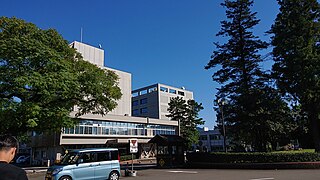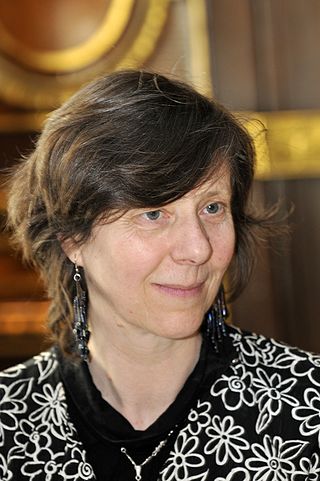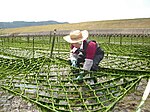
Marine biology is the scientific study of the biology of marine life, organisms that inhabit the sea. Given that in biology many phyla, families and genera have some species that live in the sea and others that live on land, marine biology classifies species based on the environment rather than on taxonomy.

Phycology is the scientific study of algae. Also known as algology, phycology is a branch of life science.

Ulva lactuca, also known by the common name sea lettuce, is an edible green alga in the family Ulvaceae. It is the type species of the genus Ulva. A synonym is U. fenestrata, referring to its "windowed" or "holed" appearance, Despite the name, it is not a lettuce
Elsie May Burrows was an English botanist who made significant contributions to British postwar phycology. Her primary area of research was macroalgal ecology, focusing particularly on Fucus, a genus of brown algae, and Chlorophyta, a division of the green algae.
Gordon Elliott Fogg was a British biologist.
Hopkins Marine Station is the marine laboratory of Stanford University. It is located ninety miles south of the university's main campus, in Pacific Grove, California on the Monterey Peninsula, adjacent to the Monterey Bay Aquarium. It is home to ten research laboratories and a fluctuating population of graduate and undergraduate students. It has also been used for archaeological exploration, including of the Chinese-American fishing village that existed on the site before burning down in 1906.

The Institute of Algological Research in Muroran is one of the oldest research institutes for phycology research in Japan. Institute of Algological Research is located in the town of Muroran, Hokkaidō, Japan and is involved in research leading to MS and PhD degrees in Phycology. Graduate students are often registered with Hokkaido University.

Kochi University is one of the 86 national universities of Japan located in Kōchi, Kōchi Prefecture. The predecessors Toya-gakusha was founded in 1874, Kochi Higher School in 1922, Kochi prefecture Teacher Training Institute for Agriculture Associated School in 1923, and it was chartered as a university in 1949.
Mary Winifred Parke, FRS, was a British marine botanist and Fellow of the Royal Society (1972) specialising in phycology, the study of algae.
Ulva ohnoi is a species of light-green coloured seaweed in the family Ulvaceae that is endemic to Japan.

Gavino Trono Jr. is a Filipino marine biologist dubbed as the "Father of Kappaphycus farming". He was conferred the rank of National Scientist of the Philippines for contributions to the study of tropical marine phycology, focusing on seaweed biodiversity. He is currently a professor emeritus of the University of the Philippines Marine Science Institute.
Madura S. Balakrishnan (1917–1990) was born and raised in Madras, Madras Presidency, British India. He was a well-known botanist and he served various government positions and worked for some time at the University of Pune. He was the student of phycologist Professor M.O.P. Iyengar. The standard author abbreviation M.S.Balakr. is used to indicate this person as the author when citing a botanical name.

Christine Adair Maggs is a British phycologist. Formerly Executive Dean of the Faculty of Science & Technology at Bournemouth University, she was the first Chief Scientist of the Joint Nature Conservation Committee, retiring in 2022. She is now an independent non-executive Director of Ocean Harvest Technology https://oceanharvesttechnology.com/corporate-governance/board-of-directors/

Wendy Alison Nelson is a New Zealand marine scientist and world expert in phycology. She is New Zealand's leading authority on seaweeds. Nelson is particularly interested in the biosystematics of seaweeds/macroalgae of New Zealand, with research on floristics, evolution and phylogeny, as well as ecology, and life history studies of marine algae. Recently she has worked on the systematics and biology of red algae including coralline algae, distribution and diversity of seaweeds in harbours and soft sediment habitats, and seaweeds of the Ross Sea and Balleny Islands.
Luigi Provasoli was an Italian phycologist, professor, and expert on the nutrition, physiology, and cultivation of algae, protozoa, and invertebrates.

Ulva australis, the southern sea lettuce, is a species of bright green coloured seaweed in the family Ulvaceae that can be found in waters around Australia and was first described by Swedish botanist Johan Erhard Areschoug. It is an edible green algae, although sometimes designated as a seaweed. General characteristics of Ulva australis include a smooth surface, distromatic blades, lobed fronds, and thallus color from dark green to light grass green. It can be either free floating or attached by a single holdfast. Its cells appear to be irregularly arranged, have rounded edges, and have shapes such as rectilinear, square, and pentagonal.
Alan Bridson Cribb Jr. is an Australian botanist and mycologist and an expert in marine and freshwater algae and seaweeds. He has also written on native and wild foods of Australia.The standard author abbreviation Cribb is used to indicate this person as the author when citing a botanical name.

Felix Bast, born as V. M. Sreejith Nambissan, is an Indian phycologist, author, and public educator based at the Central University of Punjab. He is the member of the high-profile advisory council of International Science Council, Paris, and has discovered seven new species of plants from India and Antarctica.
Evelyn Lessard is a biological oceanographer and a professor at the University of Washington's School of Oceanography.
Susan Soltau Kilham (1943–2022) was an American aquatic ecologist. She made notable contributions to phycology and to ecological stoichiometry, and much of her research focused on diatoms. Kilham has also been described as a particularly prolific and impactful scientific mentor. She served on the faculty of the University of Michigan from the early 1970s until the early 1990s, and then moved to Drexel University, where she was a professor in the Department of Biodiversity, Earth and Environmental Science, as well as chairing that department and serving on the faculty senate. Kilham received the Phycological Society of America Career Achievement Award, and is the namesake of a professorship at the University of Michigan.
















